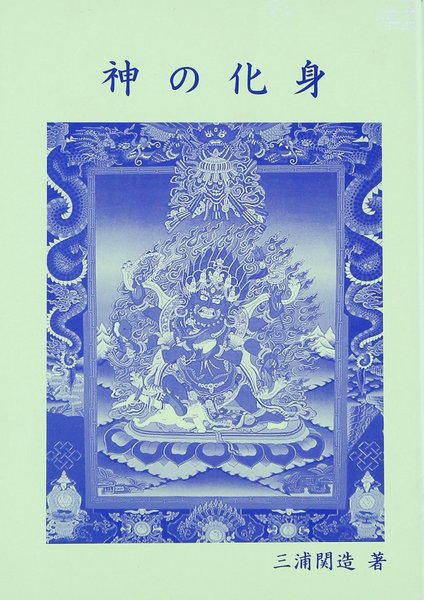 “Kami no Keshin” (“Embodiment of God” / 神の化身)
“Kami no Keshin” (“Embodiment of God” / 神の化身)
Kanzou Miura (三浦関造) – Ryuo Library (竜王文庫), 1960
Kanzou Miura was born in Fukuoka, Japan on July 15th 1883, just five months before Aikido Founder Morihei Ueshiba O-Sensei was born in Wakayama Prefecture.
After graduation from Aoyama Gakuin’s Theological School he spent one year working as a Methodist minister in the southwest of Aomori Prefecture, in Hirosaki City. He became active in the Rikugo Zasshi (六合雑誌), a Christian magazine started in 1880 by the Tokyo YMCA, and went on to publish a large number of books and translations, including translations of works by Dostoyevsky and Tolstoy. He also become interested in researching India’s first Nobel Laureate, Rabindranath Tagore.
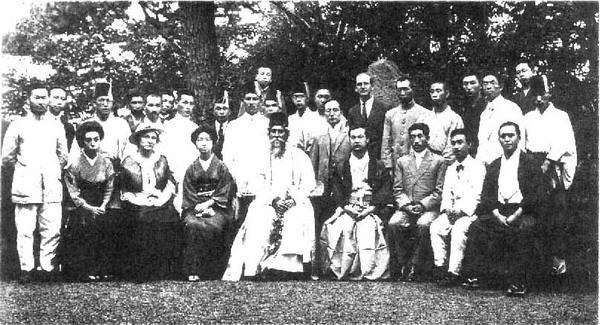 Rabindranath Tagore in Tokyo, 1916
Rabindranath Tagore in Tokyo, 1916
seated, middle of the first row
After the Second World War he organized the Ryuo-kai (Dragon King Society) and introduced theosophical teachings (including Alice Bailey and Agni Yoga) to Japan with his Synthesis Yoga practice (綜合ヨガ団体竜王会). He also translated “The Voice of the Silence” by Helena Petrovna Blavatsky and a number of other works.
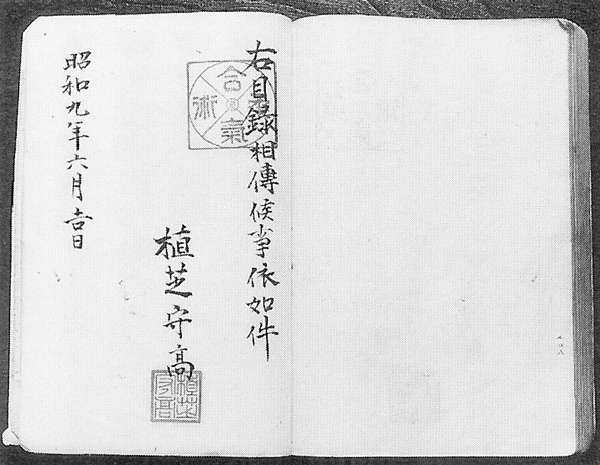 Mokuroku (目録) issued by Moritaka Ueshiba in 1934
Mokuroku (目録) issued by Moritaka Ueshiba in 1934
Stamped “Aiki-jujutsu”
From “Aikido Kaiso Ueshiba Morihei-den” (合気道開祖植芝盛平伝)
What follows is a section of a book published in 1932 by the publishing company Nito Shoin (日東書院) called “The Spirit Leaps Forward – Emergence of the Superhuman” (心霊の飛躍 – 現出の超人”/ “Shinrei no Hiyaku – Genshutsu no Chojin”). In this excerpt from that work Mr. Miura interviews Aikido Founder Morihei Ueshiba, who was then using the name Moritaka (守高).
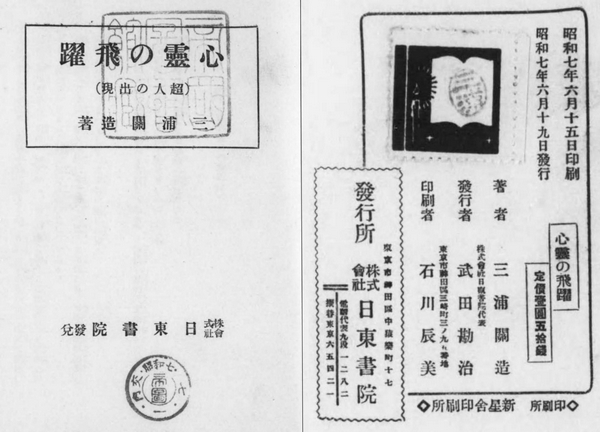 “A Leap of the Spirit” (“Shinrei no Hiyaku”) – Showa Year 7 (1932)
“A Leap of the Spirit” (“Shinrei no Hiyaku”) – Showa Year 7 (1932)
Mr. Moritaka (Morihei) Ueshiba’s Budo and the Way of the Kami
植芝守高(盛平)氏の武道と神ながら
Miyamoto Musashi is long deceased, and so it may be that the secrets of that extraordinary Budo have not been received by the ordinary people of today. Accordlingly, I would like to speak just a little about a modern figure who is thought by some to have surpassed Musashi, Mr. Moritaka (Morihei) Ueshiba.
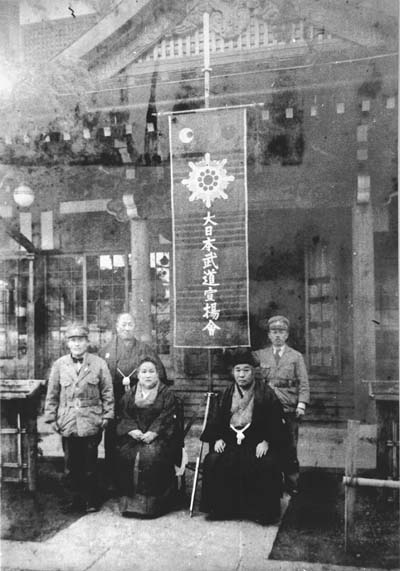 Under the Dai-Nippon Budo Senyokai (大日本武道宣揚会) banner
Under the Dai-Nippon Budo Senyokai (大日本武道宣揚会) banner
Morihei Ueshiba (left) with Sumiko and Onisaburo Deguchi in 1932
Aritoshi Murashige standing back right
Mr. Ueshiba currently has a dojo in the Ushigome area of Tokyo. This gentlemen was hidden from the public eye until two or three years ago, and that this astonishing True Budo (真の武道) existed in the world was unknown. It is rare for an authentic personage to appear in the world – in this world there are useless people who take over the country and teach their evil ways. Regardless if it is the past or the present, inside or outside the country, a righteous rule has never been realized from the beginning of things, military rule always dominates nations.
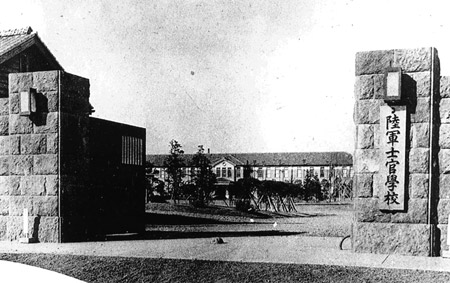 The gates of the Imperial Japanese Army Academy (陸軍士官学校)
The gates of the Imperial Japanese Army Academy (陸軍士官学校)
Few people know that in the early spring of Showa year 5 (1930) Mr. Ueshiba participated in contests at the Imperial Japanese Army Academy (陸軍士官学校). No matter how many powerfully built 5th and 6th Dan Judo-ka stepped up they were broken and played with like kittens. Even when the contest began with three strong men grasping his neck and arms they would be blown away like pieces of paper. No matter their rank in Kendo, whoever came was unable to touch him with their swords and they’d be struck and fall with a thud.
The young representatives of the Kodokan were like children before Tengu, handled without issue. Jigoro Kano, when questioned as to just what it was that the Kodokan was teaching, is said to stated “Kodokan is not Budo. It is simply physical education.”. That is how astounded he was by Mr. Ueshiba.
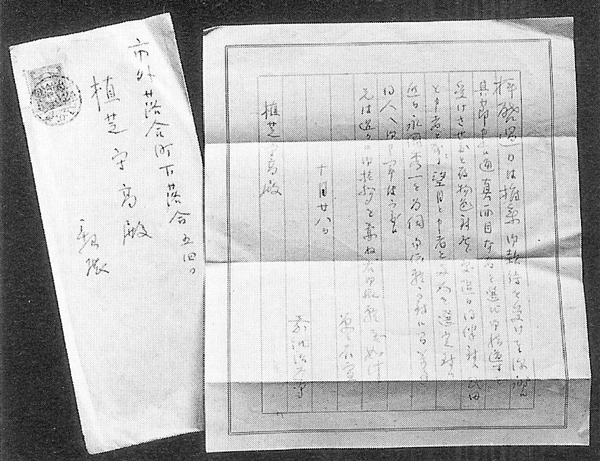 Letter from Jigoro Kano to Morihei Ueshiba
Letter from Jigoro Kano to Morihei Ueshiba
introducing Minoru Mochizuki and Jiro Takeda,
sent by the Kodokan to train at the Kobukan – October 28 1390
From “Aikido Kaiso Ueshiba Morihei-den” (合気道開祖植芝盛平伝)
According to Kisshomaru Ueshiba,
after meeting Morihei Ueshiba Jigoro Kano said:
これこそ私が理想していた武道、すなわち正真正銘の柔道である。
“This is my ideal budo, that is, genuine Judo.”
A top-ranked American boxer named “Congamu” was travelling through Europe on a “Musha Shugyo” (“Warrior Pilgrimage” / 武者修行), winning wherever he went. He appeared before Mr. Ueshiba, who was only 157cm tall, with his massively powerful 193cm frame and lunged right in with a jab – he went flying through the air upside down as if playing with a child and landed with a thud, handled without issue. He withdrew while expressing his extraordinary amazement again and again.
It was due to events like these that the world at last became aware of the person Mr. Ueshiba, and that respect for him as a superhuman Budoka and Kendoka came to be expressed. In the beginning Mr. Ueshiba was taught by Sokaku Takeda, a Budoka hidden from the world, and at the time that he parted from his teacher he had not yet reached the sacred grounds of Budo. However, it is said that Mr. Ueshiba was later taught those secrets in a dream. Moreover, the secrets of Kendo, Judo, Sumo, Boxing and more came with them, all becoming one in a demonstration of the true Way of the Kami.
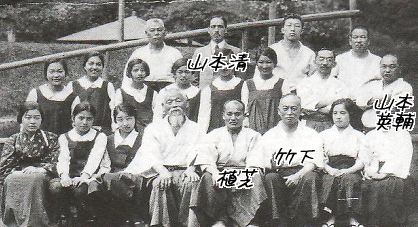 Morihei Ueshiba next to Admiral Isamu Takeshita, around 1926
Morihei Ueshiba next to Admiral Isamu Takeshita, around 1926
Center rear: son of Gonnohyoe Yamamoto*
Lt. Colonel Kiyoshi Yamamoto
Kenji Tomiki, standing back right, next to Kiyoshi Yamamoto
Right: nephew of Gonnohyoe Yamamoto*
Vice Admiral Eisuke Yamamoto
*Admiral Gonnohyoe Yamamoto was
the 16th and 22nd Prime Minister of Japan
One day, I asked Mr. Ueshiba three questions.
“I have been researching Miyamoto Musashi starting from the problem of mysticism. As far as Japan goes, there are those great philosophers, artists and men who understand things in a purely mystical way, such as Musashi and other great Kenjutsuka. In that vein, there are three things that I would like to ask you. First, to the eyes of an observer your Kendo appears to be completely electric, like the lightning movements of the Tengu. Is there a method to it? Or do you attack the opponent instinctively through some hidden power?”
This was Mr. Ueshiba’s answer:
“There is a definite method.”
“Can that method be learned by everybody?”
“It can.”
“Even so, where does that quickness come from? Your lightning movements, the sword that strikes like a flash of light, avoiding the powerfully strong hands striking at you and tossing the opponent upside down – these lightning movements?
Here Mr. Ueshiba did not answer my question, and instead made this wild statement:
“Bullets from a gun will not touch me.”
“Why is that? Does it have something to do with the power of the occult (隠秘力)?”
“No. The marksman takes aim, then at the moment that they release the safety, before the actual bullet an ethereal bullet strikes me somewhere on my body. At that moment, if I move my body slightly then the actual bullets fly in the next instant and all pass by.”
“I understand. Really, is that right? Bullets also have an ethereal form. This the first time that I’ve ever heard such a thing. I see. So, it’s as I was thinking, you are divinely inspired. I would like to ask something else, whatever method one has, however fast they shift their body, in order to play with a large and powerful man like a kitten one must have a great deal of physical power. How much power can you muster?”
“Normally, the same as a normal person, but when I put some effort into it I can carry around two bags of rice while wearing geta without a problem.”
“Really!”
As I said that he summoned one of his students. He turned to the student, who weighed between 83kg and 86kg:
“How many people was it yesterday? That got on here?”
By “here” he meant on top of his extended right arm, with the index finger supported by a chopstick stuck into the hibachi.
“It was three people.” answered the student.
“What? I don’t even need the chopstick then!” said Mr. Ueshiba. In any case, three men climbed on top of his extended right arm, which he held out with no noticeable strain. It would be as if we were doing the same with a bag of rice – times a factor of ten!
Seeing my surprise, this is what Mr. Ueshiba said:
“However strong the opponent is, when I stand to face them the power to overcome them, power that I don’t myself understand, comes forth. Moreover, I don’t know anything about what kind of an art Shinto-ryu (神道流) is, but when I contest with Shinto-ryu’s Mr. Otsuka, my hands become completely Shinto-ryu hands. When I meet with a Judo-ka my hands become the hands of Judo”
“What do you mean?”
“I become completely transparent, the opponent is transformed into their ethereal body and I am possessed by my guardian spirit. The other person disappears and I am just attacked by their hands and form. The more that the other person’s Shugyo has progressed the greater their ethereal body and the guardian spirit, so I must also become greater. In any case, the state of my heart when facing an opponent is as transparent as a mirror, so in this state the other person’s spirit is perfectly refelected.”
“I see, that is the the secret of the Void in Miyamoto Musashi’s Nito-ichi Ryu. Here also you are in agreement with Miyamoto Musashi.”
“Wherever he went and whatever contests he participated in Musashi would be victorious in the challenge, so I am told.”
 The Yoshida family copy of Miyamoto Musashi’s “Book of the Void” (空の巻)
The Yoshida family copy of Miyamoto Musashi’s “Book of the Void” (空の巻)
The secret of the Void in Miyamoto Musashi’s Nito-ichi Ryu is the secret if every great religion, and also the secret of the Way of the Kami, the secret of Christ who became divine at the age of thirty. This is how Musashi explains it:
(*Translator’s Note: the text given here is from Musashi’s “Go Rin no Sho” (“Book of Five Rings”), I have included the classic translation by Victor Harris)
“The Ni To Ichi Way of strategy is recorded in this the Book of the Void.
What is called the spirit of the void is where there is nothing. It is not included in man’s knowledge. Of course the void is nothingness. By knowing things that exist, you can know that which does not exist. That is the void.
People in this world look at things mistakenly, and think that what they do not understand must be the void. This is not the true void. It is bewilderment.
In the Way of strategy, also, those who study as warriors think that whatever they cannot understand in their craft is the void. This is not the true void.
To attain the Way of strategy as a warrior you must study fully other martial arts and not deviate even a little from the Way of the warrior. With your spirit settled, accumulate practice day by day, and hour by hour. Polish the twofold spirit heart and mind, and sharpen the twofold gaze perception and sight. When your spirit is not in the least clouded, when the clouds of bewilderment clear away, there is the true void.
Until you realise the true Way, whether in Buddhism or in common sense, you may think that things are correct and in order. However, if we look at things objectively, from the viewpoint of laws of the world, we see various doctrines departing from the true Way. Know well this spirit, and with forthrightness as the foundation and the true spirit as the Way. Enact strategy broadly, correctly and openly.
Then you will come to think of things in a wide sense and, taking the void as the Way, you will see the Way as void.
In the void is virtue, and no evil. Wisdom has existence, principle has existence, the Way has existence, spirit is nothingness.”
These words did not in any way come from Zen Buddhism, they are an astounding state of mind coming from Musashi’s personal experiences. Since these words from the four dimensional world are far above and beyond the domain of logical philosophy, if one reads them with normal common sense they will not be able to grasp the secret. One will be able to grasp their intent even less when considering them philosophically or scientifically. The words are simple, but they reach the meaning. It is the world that appears from polishing, deepening, lifting up the Way, Strategy, Art, and actual life to its limits.
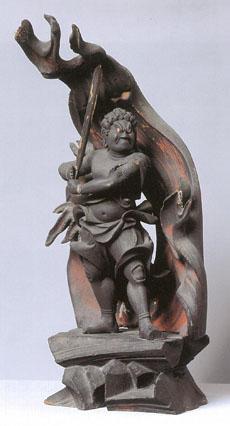 Fudo Myo (“Immovable Wisdom” / 不動明王)
Fudo Myo (“Immovable Wisdom” / 不動明王)
carved by Miyamoto Musashi
“Void as the Way, the Way as Void” is the Way that appears from the transcendent world, and the transcendent world appears from the perfection of the Way. That which does not exist in this world appears through the perfection of the Way, that is to say the manifestation of the Kami.
Until now Mr. Ueshiba has devoted himself not only to Kendo, but also to the Way. His strenuous efforts to the present day have actually been the Shugyo of the Way.
He spent many hard years in training the Way through certain ersatz religions, but in the end it was through Ancient Shinto that he reached the Way of the Kami and realized the secrets of Kendo. When his training in Kendo reached the stage of the Way of the Kami, entering form and escaping form, he attained the realization that all schools of Kendo become one. It is because Mr. Ueshiba’s Budo has actually reached this realm of the Kami that the forms are not set. Actually, even now, in the Way of the Kami, secret methods are being created one after the other. Progress is made day after day. This is the Way of the Kami. One can know the Way of the Kami through form, but one cannot enter there without surpassing form. For that reason, in Miyamoto Musashi’s Strategy and the secrets of Kendo the mind is the ruler, the rest are methods for learning the way directly to the mind. Materialism crumbles before this amazing truth.
In Mr. Ueshiba’s contests the opponent becomes an ethereal body, and a guardian spirit possesses Mr. Ueshiba’s empty heart. This type of language is something that someone who does not practice spiritual philosophy or spiritualism will not understand, but that this would be clear to someone researching Japanese ancient Shinto cannot be doubted.
When the 157cm tall Mr. Ueshiba faced large and powerful opponents of 193cm and more, the other people were also quite strong. However, in the midst of the engagement he was able to see a white body that had fallen on the ground and the opponent would fall into that white body without being pushed or controlled (the opponents ethereal body had separated from their physical body and could be seen on the ground by Mr. Ueshiba’s spiritual eye). In a manner of speaking, his soul had already broken out and been defeated.
So, the matter of the physical body is clothing for the ethereal body, the ethereal body is clothing for the spiritual body. If the physical body dies then we live as the ethereal body, but at some point as it progresses along the way the ethereal body dies and melts into the spiritual body. Humans living in the physical body can also open themselves to consciousness of the soul as the ethereal body as they progress mentally, and as they further refine themselves they can open themselves to consciousness of the spirit. Further, consciousness of the soul or spirit surpasses the normal consciousness of human beings, and brings with it great power and wisdom.
When the literary giant Goethe said “I met myself” it was that he saw his own ethereal body that had broken free from his physical body, there are many actual examples even in Japan today. The consciousness of the spirit in the spiritual body more easily senses artistic beauty, and is an even further refinement over the consciousness of the ethereal body in the soul. As in Plato’s conception of music as stirring the soul, the correct perspective is to think of the world of ideas setting our spirits on fire. Through this one can truly understand that all true philosophers and great artists are mysterious.
When one reaches the level of Moritaka (Morihei) Ueshiba in Kendo, one’s goal is not to conquer or kill others. Further, it is not simply a matter of protecting one’s own body. Mr. Ueshiba’s Kendo is not a process of competition of the physcial body, it is something transcendental of the ethereal body. The Way of the Kami leading to a shining inner light. While training in the sword he often had the experience of becoming surrounded with a purple light, his breath becoming one with all things. That is to say, reaching the extremities of Kendo, said to be the realm in which one enters the consciousness of the spirit surpassing the physical body.
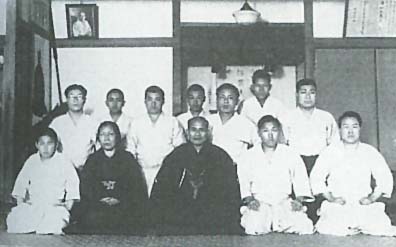 Morihei Ueshiba and uchi-deshi at the Kobukan
Morihei Ueshiba and uchi-deshi at the Kobukan
Ushigome, Wakamatsu-cho 1931
Currently Mr. Ueshiba instructs military personnel in Kendo and members of the Imperial household in Budo. At the dojo in Ushigome, in addition to nameless youths and young Kodokan 5th and 6th dans, major generals, lieutenant generals and admirals are enrolling as students. If the technique is from the Way of the Kami, whether one calls it Kendo, Judo or Sumo it is all instruction in the mysteries. In the past few days I have seen a famous Sumo wrestler more than 2m 13cm in height puzzled and confused as he was reversed and thrown by a small man who had just begun to train as a student of Mr. Ueshiba. One can see how extraordinary this is. Nowadays, even the daughter of Mr. Chigaku Tanaka has come to be seen regularly at training.
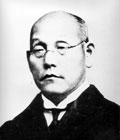 Chigaku Tanaka (田中智學) around 1928
Chigaku Tanaka (田中智學) around 1928
Nichiren Buddhist Scholar and right-wing nationalist propagandist
Published by: Christopher Li – Honolulu, HI

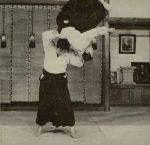





Leave a Reply